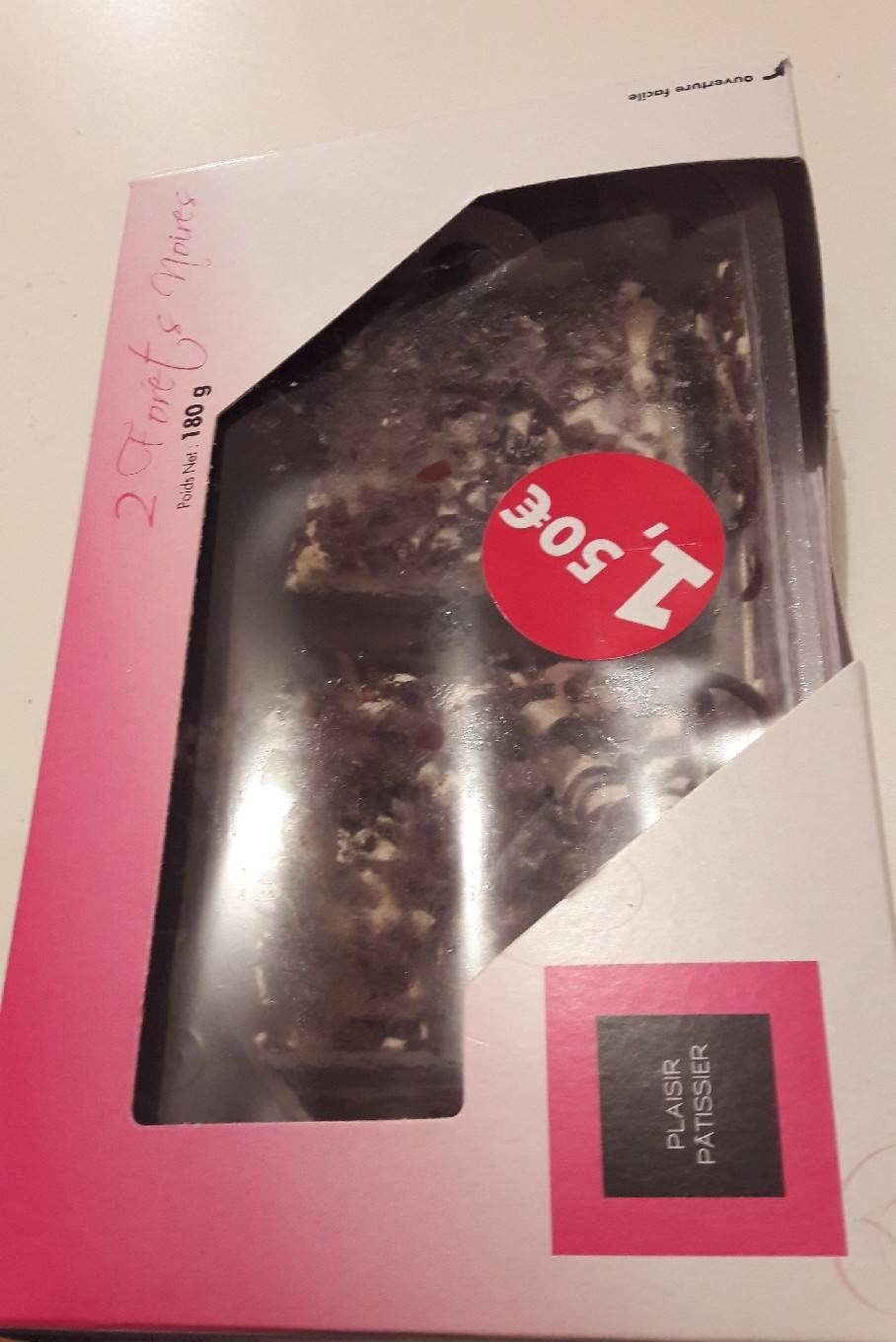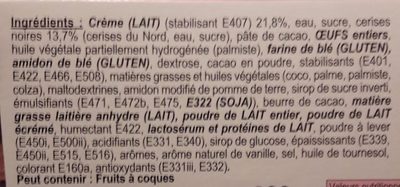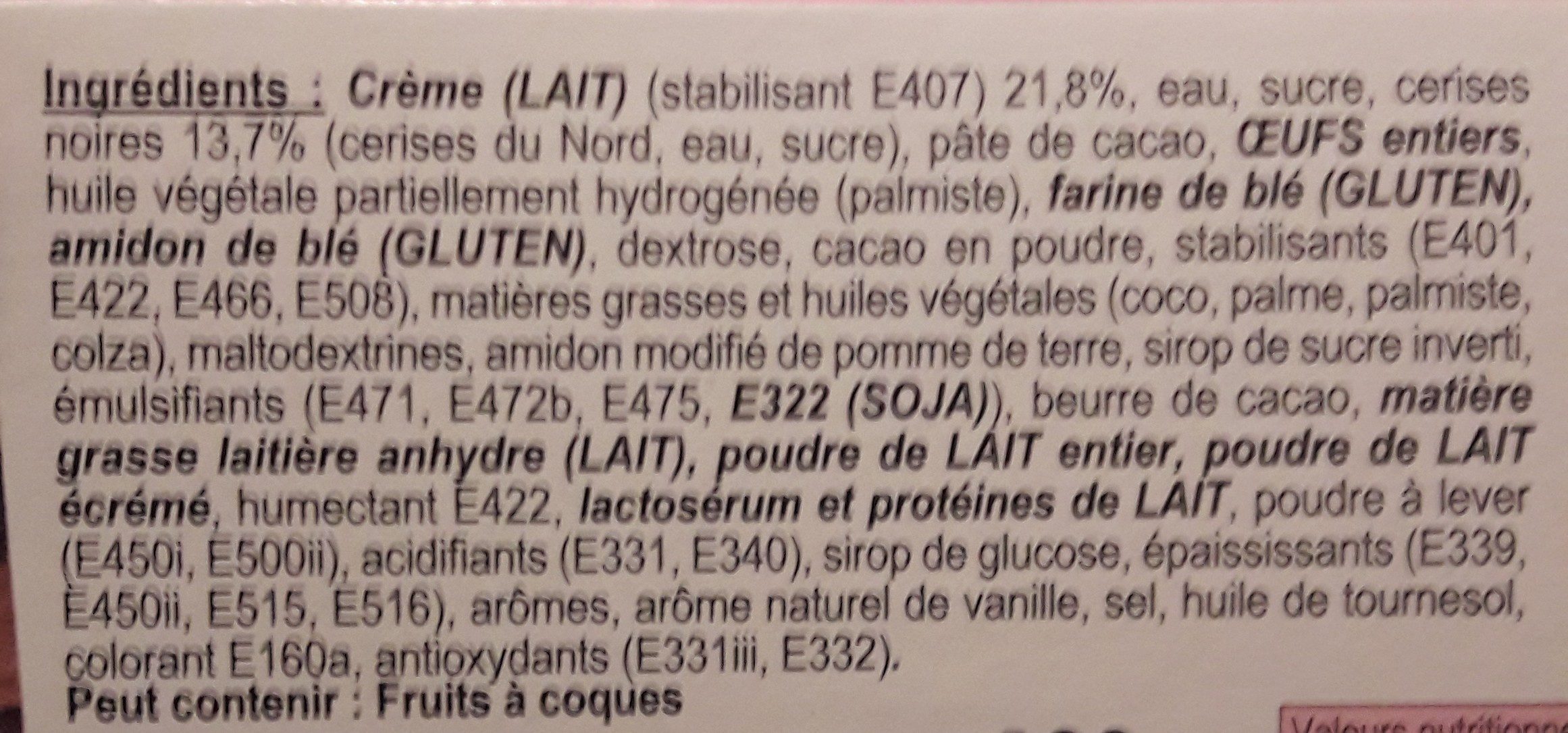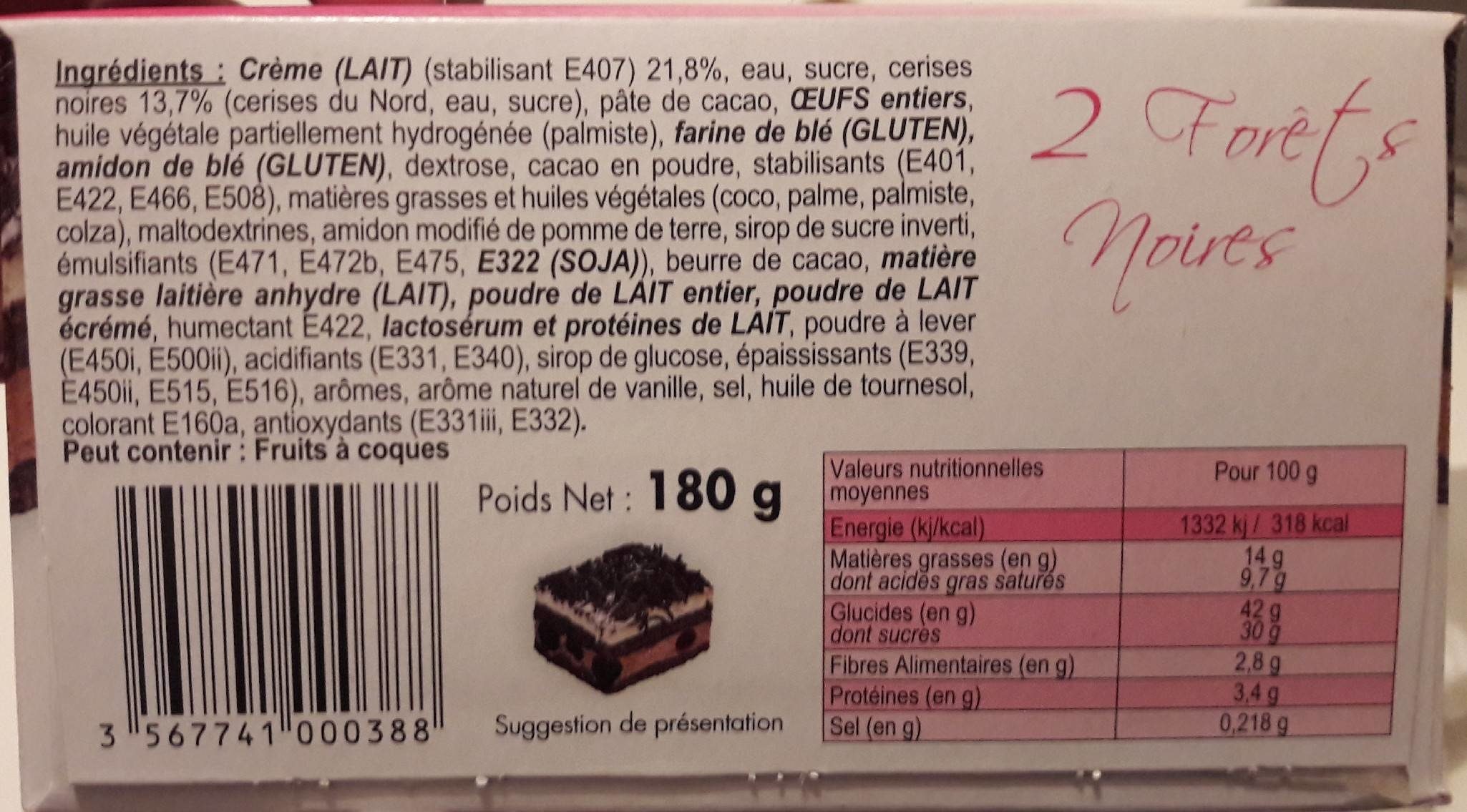Help us make food transparency the norm!
As a non-profit organization, we depend on your donations to continue informing consumers around the world about what they eat.
The food revolution starts with you!
2 Forêts noires - Plaisir Pâtissier - 180 g
2 Forêts noires - Plaisir Pâtissier - 180 g
This product page is not complete. You can help to complete it by editing it and adding more data from the photos we have, or by taking more photos using the app for Android or iPhone/iPad. Thank you!
×
Barcode: 3567741000388 (EAN / EAN-13)
Quantity: 180 g
Brands: Plaisir Pâtissier
Categories: Snacks, Desserts, Sweet snacks, Biscuits and cakes, Cakes, Black Forest gâteau
Countries where sold: France
Matching with your preferences
Health
Ingredients
-
60 ingredients
: Crème (LAIT) (stabilisant E407) 21,8%, eau, sucre, cerises noires 13,7 % (cerises du Nord, eau, sucre), pâte do cacao, ŒUFS entiers, huile végétale partiellernent hydrogénée (palmiste), farine de blé (GLUTEN), amidon de blé (GLUTEN), dextrose, cacao on poudre, stabilisants (E401, E422, E466, E500), matières grasses et huiles végétales (coco, palme, palmiste, colza), maltodextrines, amidon modifié do pomme de terre, sirop de sucre inverti, émulsifiants (E471, E472b, E475, E322 (soJA)), beurre de cacao, matière grasse laitière anhydre (LAIT), poudre de LAIT entier, poudre de LAIT écrémé, humectant E422, lactosérum ot protéines de LAIT, poudre à lever (E450i, E500ii), acidifiants (E331 , E340), sirop do glucose, épaississants (E339, E450ii, E515, E516), arômes, arôme naturel do vanille, sel, huile de tournesol, colorant antioxydants (E331iii, E332). Peut contenir : Fruits à coquesAllergens: Eggs, Gluten, Milk, SoybeansTraces: Nuts
Food processing
-
Ultra processed foods
Elements that indicate the product is in the 4 - Ultra processed food and drink products group:
- Additive: E14XX - Modified Starch
- Additive: E322 - Lecithins
- Additive: E401 - Sodium alginate
- Additive: E407 - Carrageenan
- Additive: E422 - Glycerol
- Additive: E450 - Diphosphates
- Additive: E466 - Sodium carboxy methyl cellulose
- Additive: E471 - Mono- and diglycerides of fatty acids
- Additive: E472b - Lactic acid esters of mono- and diglycerides of fatty acids
- Additive: E475 - Polyglycerol esters of fatty acids
- Ingredient: Dextrose
- Ingredient: Emulsifier
- Ingredient: Flavouring
- Ingredient: Glucose
- Ingredient: Humectant
- Ingredient: Invert sugar
- Ingredient: Maltodextrin
- Ingredient: Thickener
Food products are classified into 4 groups according to their degree of processing:
- Unprocessed or minimally processed foods
- Processed culinary ingredients
- Processed foods
- Ultra processed foods
The determination of the group is based on the category of the product and on the ingredients it contains.
Additives
-
E322 - Lecithins
Lecithins are natural compounds commonly used in the food industry as emulsifiers and stabilizers.
Extracted from sources like soybeans and eggs, lecithins consist of phospholipids that enhance the mixing of oil and water, ensuring smooth textures in various products like chocolates, dressings, and baked goods.
They do not present any known health risks.
-
E331 - Sodium citrates
Sodium citrate: Sodium citrate may refer to any of the sodium salts of citrate -though most commonly the third-: Monosodium citrate Disodium citrate Trisodium citrateThe three forms of the salt are collectively known by the E number E331. Sodium citrates are used as acidity regulators in food and drinks, and also as emulsifiers for oils. They enable cheeses to melt without becoming greasy.Source: Wikipedia
-
E331iii - Trisodium citrate
Sodium citrate: Sodium citrate may refer to any of the sodium salts of citrate -though most commonly the third-: Monosodium citrate Disodium citrate Trisodium citrateThe three forms of the salt are collectively known by the E number E331. Sodium citrates are used as acidity regulators in food and drinks, and also as emulsifiers for oils. They enable cheeses to melt without becoming greasy.Source: Wikipedia
-
E332 - Potassium citrates
Potassium citrate: Potassium citrate -also known as tripotassium citrate- is a potassium salt of citric acid with the molecular formula K3C6H5O7. It is a white, hygroscopic crystalline powder. It is odorless with a saline taste. It contains 38.28% potassium by mass. In the monohydrate form it is highly hygroscopic and deliquescent. As a food additive, potassium citrate is used to regulate acidity and is known as E number E332. Medicinally, it may be used to control kidney stones derived from either uric acid or cystine.Source: Wikipedia
-
E339 - Sodium phosphates
Sodium phosphates: Sodium phosphate is a generic term for a variety of salts of sodium -Na+- and phosphate -PO43−-. Phosphate also forms families or condensed anions including di-, tri-, tetra-, and polyphosphates. Most of these salts are known in both anhydrous -water-free- and hydrated forms. The hydrates are more common than the anhydrous forms.Source: Wikipedia
-
E340 - Potassium phosphates
Potassium phosphate: Potassium phosphate is a generic term for the salts of potassium and phosphate ions including: Monopotassium phosphate -KH2PO4- -Molar mass approx: 136 g/mol- Dipotassium phosphate -K2HPO4- -Molar mass approx: 174 g/mol- Tripotassium phosphate -K3PO4- -Molar mass approx: 212.27 g/mol-As food additives, potassium phosphates have the E number E340.Source: Wikipedia
-
E407 - Carrageenan
Carrageenan (E407), derived from red seaweed, is widely employed in the food industry as a gelling, thickening, and stabilizing agent, notably in dairy and meat products.
It can exist in various forms, each imparting distinct textural properties to food.
However, its degraded form, often referred to as poligeenan, has raised health concerns due to its potential inflammatory effects and its classification as a possible human carcinogen (Group 2B) by the International Agency for Research on Cancer (IARC).
Nevertheless, food-grade carrageenan has been deemed safe by various regulatory bodies when consumed in amounts typically found in food.
-
E422 - Glycerol
Glycerol: Glycerol -; also called glycerine or glycerin; see spelling differences- is a simple polyol compound. It is a colorless, odorless, viscous liquid that is sweet-tasting and non-toxic. The glycerol backbone is found in all lipids known as triglycerides. It is widely used in the food industry as a sweetener and humectant and in pharmaceutical formulations. Glycerol has three hydroxyl groups that are responsible for its solubility in water and its hygroscopic nature.Source: Wikipedia
-
E450 - Diphosphates
Diphosphates (E450) are food additives often utilized to modify the texture of products, acting as leavening agents in baking and preventing the coagulation of canned food.
These salts can stabilize whipped cream and are also found in powdered products to maintain their flow properties. They are commonly present in baked goods, processed meats, and soft drinks.
Derived from phosphoric acid, they're part of our daily phosphate intake, which often surpasses recommended levels due to the prevalence of phosphates in processed foods and drinks.
Excessive phosphate consumption is linked to health issues, such as impaired kidney function and weakened bone health. Though diphosphates are generally regarded as safe when consumed within established acceptable daily intakes, it's imperative to monitor overall phosphate consumption to maintain optimal health.
-
E466 - Sodium carboxy methyl cellulose
Carboxymethyl cellulose: Carboxymethyl cellulose -CMC- or cellulose gum or tylose powder is a cellulose derivative with carboxymethyl groups --CH2-COOH- bound to some of the hydroxyl groups of the glucopyranose monomers that make up the cellulose backbone. It is often used as its sodium salt, sodium carboxymethyl cellulose.Source: Wikipedia
-
E471 - Mono- and diglycerides of fatty acids
Mono- and diglycerides of fatty acids (E471), are food additives commonly used as emulsifiers in various processed foods.
These compounds consist of glycerol molecules linked to one or two fatty acid chains, which help stabilize and blend water and oil-based ingredients. E471 enhances the texture and shelf life of products like margarine, baked goods, and ice cream, ensuring a smooth and consistent texture.
It is generally considered safe for consumption within established regulatory limits.
-
E500 - Sodium carbonates
Sodium carbonates (E500) are compounds commonly used in food preparation as leavening agents, helping baked goods rise by releasing carbon dioxide when they interact with acids.
Often found in baking soda, they regulate the pH of food, preventing it from becoming too acidic or too alkaline. In the culinary world, sodium carbonates can also enhance the texture and structure of foods, such as noodles, by modifying the gluten network.
Generally recognized as safe, sodium carbonates are non-toxic when consumed in typical amounts found in food.
-
E500ii - Sodium hydrogen carbonate
Sodium hydrogen carbonate, also known as E500ii, is a food additive commonly used as a leavening agent.
When added to recipes, it releases carbon dioxide gas upon exposure to heat or acids, causing dough to rise and resulting in a light, fluffy texture in baked goods.
It is generally recognized as safe (GRAS) by regulatory authorities when used in appropriate quantities and poses no significant health risks when consumed in typical food applications.
-
E515 - Potassium sulphates
Potassium sulfate: Potassium sulfate -K2SO4- -in British English potassium sulphate, also called sulphate of potash, arcanite, or archaically known as potash of sulfur- is a non-flammable white crystalline salt which is soluble in water. The chemical compound is commonly used in fertilizers, providing both potassium and sulfur. When potassium sulfate is heated in water and subjected to swirling in a beaker, the crystals form a multi-arm spiral structure when allowed to settle. Potassium sulfate could be used to study spiral structures in the laboratory.Source: Wikipedia
-
E516 - Calcium sulphate
Calcium sulfate: Calcium sulfate -or calcium sulphate- is the inorganic compound with the formula CaSO4 and related hydrates. In the form of γ-anhydrite -the anhydrous form-, it is used as a desiccant. One particular hydrate is better known as plaster of Paris, and another occurs naturally as the mineral gypsum. It has many uses in industry. All forms are white solids that are poorly soluble in water. Calcium sulfate causes permanent hardness in water.Source: Wikipedia
Ingredients analysis
-
Palm oil
Ingredients that contain palm oil: Palm kernel oil, Palm oil, Palm kernel oil
-
Non-vegan
Non-vegan ingredients: Cream, Whole egg, Whole milk powder, Skimmed milk powderSome ingredients could not be recognized.
We need your help!
You can help us recognize more ingredients and better analyze the list of ingredients for this product and others:
- Edit this product page to correct spelling mistakes in the ingredients list, and/or to remove ingredients in other languages and sentences that are not related to the ingredients.
- Add new entries, synonyms or translations to our multilingual lists of ingredients, ingredient processing methods, and labels.
If you would like to help, join the #ingredients channel on our Slack discussion space and/or learn about ingredients analysis on our wiki. Thank you!
-
Vegetarian status unknown
Unrecognized ingredients: fr:cerises-du-nord, fr:pate-do-cacao, fr:huile-vegetale-partiellernent-hydrogenee, fr:cacao-on-poudre, fr:amidon-modifie-do-pomme-de-terre, fr:Matière grasse de lait anhydre, fr:lactoserum-ot-proteines-de-lait, fr:sirop-do-glucose, fr:arome-naturel-do-vanille, fr:colorant-antioxydantsSome ingredients could not be recognized.
We need your help!
You can help us recognize more ingredients and better analyze the list of ingredients for this product and others:
- Edit this product page to correct spelling mistakes in the ingredients list, and/or to remove ingredients in other languages and sentences that are not related to the ingredients.
- Add new entries, synonyms or translations to our multilingual lists of ingredients, ingredient processing methods, and labels.
If you would like to help, join the #ingredients channel on our Slack discussion space and/or learn about ingredients analysis on our wiki. Thank you!
-
Details of the analysis of the ingredients
We need your help!
Some ingredients could not be recognized.
We need your help!
You can help us recognize more ingredients and better analyze the list of ingredients for this product and others:
- Edit this product page to correct spelling mistakes in the ingredients list, and/or to remove ingredients in other languages and sentences that are not related to the ingredients.
- Add new entries, synonyms or translations to our multilingual lists of ingredients, ingredient processing methods, and labels.
If you would like to help, join the #ingredients channel on our Slack discussion space and/or learn about ingredients analysis on our wiki. Thank you!
: Crème (stabilisant (e407)), eau, sucre, cerises noires 13.7% (cerises du Nord, eau, sucre), pâte do cacao, ŒUFS entiers, huile végétale partiellernent hydrogénée (palmiste), farine de blé, amidon de blé, dextrose, cacao on poudre, stabilisants (e401, e422, e466, e500), matières grasses et huiles végétales de coco, huiles végétales de palme, huiles végétales de palmiste, huiles végétales de colza, maltodextrines, amidon modifié do pomme de terre, sirop de sucre inverti, émulsifiants (e471, e472b, e475, e322), beurre de cacao, matière grasse laitière anhydre, poudre de LAIT entier, poudre de LAIT écrémé, humectant (e422), lactosérum ot protéines de LAIT, poudre à lever (e450i, e500ii), acidifiants (e331, e340), sirop do glucose, épaississants (e339, e450ii, e515, e516), arômes, arôme naturel do vanille, sel, huile de tournesol, colorant antioxydants (e331iii, e332)- Crème -> en:cream - vegan: no - vegetarian: yes - ciqual_food_code: 19402 - percent_min: 13.7 - percent_max: 58.9
- stabilisant -> en:stabiliser - percent_min: 13.7 - percent_max: 58.9
- e407 -> en:e407 - vegan: yes - vegetarian: yes - percent_min: 13.7 - percent_max: 58.9
- stabilisant -> en:stabiliser - percent_min: 13.7 - percent_max: 58.9
- eau -> en:water - vegan: yes - vegetarian: yes - ciqual_food_code: 18066 - percent_min: 13.7 - percent_max: 36.3
- sucre -> en:sugar - vegan: yes - vegetarian: yes - ciqual_proxy_food_code: 31016 - percent_min: 13.7 - percent_max: 28.7666666666667
- cerises noires -> en:black-cherry - vegan: yes - vegetarian: yes - ciqual_food_code: 13008 - percent_min: 13.7 - percent: 13.7 - percent_max: 13.7
- cerises du Nord -> fr:cerises-du-nord - percent_min: 4.56666666666667 - percent_max: 13.7
- eau -> en:water - vegan: yes - vegetarian: yes - ciqual_food_code: 18066 - percent_min: 0 - percent_max: 6.85
- sucre -> en:sugar - vegan: yes - vegetarian: yes - ciqual_proxy_food_code: 31016 - percent_min: 0 - percent_max: 4.56666666666667
- pâte do cacao -> fr:pate-do-cacao - percent_min: 0 - percent_max: 13.7
- ŒUFS entiers -> en:whole-egg - vegan: no - vegetarian: yes - ciqual_food_code: 22000 - percent_min: 0 - percent_max: 13.7
- huile végétale partiellernent hydrogénée -> fr:huile-vegetale-partiellernent-hydrogenee - percent_min: 0 - percent_max: 11.78
- palmiste -> en:palm-kernel-oil - vegan: yes - vegetarian: yes - from_palm_oil: yes - percent_min: 0 - percent_max: 11.78
- farine de blé -> en:wheat-flour - vegan: yes - vegetarian: yes - ciqual_proxy_food_code: 9410 - percent_min: 0 - percent_max: 9.81666666666667
- amidon de blé -> en:wheat-starch - vegan: yes - vegetarian: yes - ciqual_proxy_food_code: 9510 - percent_min: 0 - percent_max: 8.41428571428571
- dextrose -> en:dextrose - vegan: yes - vegetarian: yes - ciqual_proxy_food_code: 31016 - percent_min: 0 - percent_max: 7.3625
- cacao on poudre -> fr:cacao-on-poudre - percent_min: 0 - percent_max: 6.54444444444445
- stabilisants -> en:stabiliser - percent_min: 0 - percent_max: 5.89
- e401 -> en:e401 - vegan: yes - vegetarian: yes - percent_min: 0 - percent_max: 5.89
- e422 -> en:e422 - vegan: maybe - vegetarian: maybe - percent_min: 0 - percent_max: 2.945
- e466 -> en:e466 - vegan: yes - vegetarian: yes - percent_min: 0 - percent_max: 1.96333333333333
- e500 -> en:e500 - vegan: yes - vegetarian: yes - percent_min: 0 - percent_max: 1.4725
- matières grasses et huiles végétales de coco -> en:coconut-fat - vegan: yes - vegetarian: yes - from_palm_oil: no - ciqual_food_code: 16040 - percent_min: 0 - percent_max: 5.35454545454546
- huiles végétales de palme -> en:palm-oil - vegan: yes - vegetarian: yes - from_palm_oil: yes - ciqual_food_code: 16129 - percent_min: 0 - percent_max: 4.90833333333333
- huiles végétales de palmiste -> en:palm-kernel-oil - vegan: yes - vegetarian: yes - from_palm_oil: yes - percent_min: 0 - percent_max: 4.53076923076923
- huiles végétales de colza -> en:colza-oil - vegan: yes - vegetarian: yes - from_palm_oil: no - ciqual_food_code: 17130 - percent_min: 0 - percent_max: 4.20714285714286
- maltodextrines -> en:maltodextrin - vegan: yes - vegetarian: yes - percent_min: 0 - percent_max: 3.92666666666667
- amidon modifié do pomme de terre -> fr:amidon-modifie-do-pomme-de-terre - percent_min: 0 - percent_max: 3.68125
- sirop de sucre inverti -> en:invert-sugar-syrup - vegan: yes - vegetarian: yes - percent_min: 0 - percent_max: 3.46470588235294
- émulsifiants -> en:emulsifier - percent_min: 0 - percent_max: 3.27222222222222
- e471 -> en:e471 - vegan: maybe - vegetarian: maybe - from_palm_oil: maybe - percent_min: 0 - percent_max: 3.27222222222222
- e472b -> en:e472b - vegan: maybe - vegetarian: maybe - from_palm_oil: maybe - percent_min: 0 - percent_max: 1.63611111111111
- e475 -> en:e475 - vegan: maybe - vegetarian: maybe - percent_min: 0 - percent_max: 1.09074074074074
- e322 -> en:e322 - vegan: maybe - vegetarian: maybe - percent_min: 0 - percent_max: 0.818055555555556
- beurre de cacao -> en:cocoa-butter - vegan: yes - vegetarian: yes - ciqual_food_code: 16030 - percent_min: 0 - percent_max: 3.1
- matière grasse laitière anhydre -> fr:matiere-grasse-de-lait-anhydre - percent_min: 0 - percent_max: 2.945
- poudre de LAIT entier -> en:whole-milk-powder - vegan: no - vegetarian: yes - ciqual_food_code: 19021 - percent_min: 0 - percent_max: 2.80476190476191
- poudre de LAIT écrémé -> en:skimmed-milk-powder - vegan: no - vegetarian: yes - ciqual_food_code: 19054 - percent_min: 0 - percent_max: 2.67727272727273
- humectant -> en:humectant - percent_min: 0 - percent_max: 2.56086956521739
- e422 -> en:e422 - vegan: maybe - vegetarian: maybe - percent_min: 0 - percent_max: 2.56086956521739
- lactosérum ot protéines de LAIT -> fr:lactoserum-ot-proteines-de-lait - percent_min: 0 - percent_max: 2.45416666666667
- poudre à lever -> en:raising-agent - percent_min: 0 - percent_max: 2.356
- e450i -> en:e450i - vegan: yes - vegetarian: yes - percent_min: 0 - percent_max: 2.356
- e500ii -> en:e500ii - vegan: yes - vegetarian: yes - percent_min: 0 - percent_max: 1.178
- acidifiants -> en:acid - percent_min: 0 - percent_max: 2.26538461538462
- e331 -> en:e331 - vegan: yes - vegetarian: yes - percent_min: 0 - percent_max: 2.26538461538462
- e340 -> en:e340 - vegan: yes - vegetarian: yes - percent_min: 0 - percent_max: 1.13269230769231
- sirop do glucose -> fr:sirop-do-glucose - percent_min: 0 - percent_max: 2.18148148148148
- épaississants -> en:thickener - percent_min: 0 - percent_max: 2.10357142857143
- e339 -> en:e339 - vegan: yes - vegetarian: yes - percent_min: 0 - percent_max: 2.10357142857143
- e450ii -> en:e450ii - vegan: yes - vegetarian: yes - percent_min: 0 - percent_max: 1.05178571428571
- e515 -> en:e515 - vegan: yes - vegetarian: yes - percent_min: 0 - percent_max: 0.701190476190476
- e516 -> en:e516 - vegan: yes - vegetarian: yes - percent_min: 0 - percent_max: 0.525892857142857
- arômes -> en:flavouring - vegan: maybe - vegetarian: maybe - percent_min: 0 - percent_max: 2.03103448275862
- arôme naturel do vanille -> fr:arome-naturel-do-vanille - percent_min: 0 - percent_max: 1.96333333333333
- sel -> en:salt - vegan: yes - vegetarian: yes - ciqual_food_code: 11058 - percent_min: 0 - percent_max: 0.218
- huile de tournesol -> en:sunflower-oil - vegan: yes - vegetarian: yes - from_palm_oil: no - ciqual_food_code: 17440 - percent_min: 0 - percent_max: 0.218
- colorant antioxydants -> fr:colorant-antioxydants - percent_min: 0 - percent_max: 0.218
- e331iii -> en:e331iii - vegan: yes - vegetarian: yes - percent_min: 0 - percent_max: 0.218
- e332 -> en:e332 - vegan: yes - vegetarian: yes - percent_min: 0 - percent_max: 0.109
Nutrition
-
Poor nutritional quality
⚠ ️Warning: the amount of fruits, vegetables and nuts is not specified on the label, it was estimated from the list of ingredients: 13This product is not considered a beverage for the calculation of the Nutri-Score.
Positive points: 2
- Proteins: 2 / 5 (value: 3.4, rounded value: 3.4)
- Fiber: 2 / 5 (value: 2.8, rounded value: 2.8)
- Fruits, vegetables, nuts, and colza/walnut/olive oils: 0 / 5 (value: 13.7009195963542, rounded value: 13.7)
Negative points: 18
- Energy: 3 / 10 (value: 1331, rounded value: 1331)
- Sugars: 6 / 10 (value: 30, rounded value: 30)
- Saturated fat: 9 / 10 (value: 9.7, rounded value: 9.7)
- Sodium: 0 / 10 (value: 87.2, rounded value: 87.2)
The points for proteins are not counted because the negative points are greater or equal to 11.
Nutritional score: (18 - 2)
Nutri-Score:
-
Nutrient levels
-
Fat in moderate quantity (14%)
What you need to know- A high consumption of fat, especially saturated fats, can raise cholesterol, which increases the risk of heart diseases.
Recommendation: Limit the consumption of fat and saturated fat- Choose products with lower fat and saturated fat content.
-
Saturated fat in high quantity (9.7%)
What you need to know- A high consumption of fat, especially saturated fats, can raise cholesterol, which increases the risk of heart diseases.
Recommendation: Limit the consumption of fat and saturated fat- Choose products with lower fat and saturated fat content.
-
Sugars in high quantity (30%)
What you need to know- A high consumption of sugar can cause weight gain and tooth decay. It also augments the risk of type 2 diabetes and cardio-vascular diseases.
Recommendation: Limit the consumption of sugar and sugary drinks- Sugary drinks (such as sodas, fruit beverages, and fruit juices and nectars) should be limited as much as possible (no more than 1 glass a day).
- Choose products with lower sugar content and reduce the consumption of products with added sugars.
-
Salt in low quantity (0.218%)
What you need to know- A high consumption of salt (or sodium) can cause raised blood pressure, which can increase the risk of heart disease and stroke.
- Many people who have high blood pressure do not know it, as there are often no symptoms.
- Most people consume too much salt (on average 9 to 12 grams per day), around twice the recommended maximum level of intake.
Recommendation: Limit the consumption of salt and salted food- Reduce the quantity of salt used when cooking, and don't salt again at the table.
- Limit the consumption of salty snacks and choose products with lower salt content.
-
-
Nutrition facts
Nutrition facts As sold
for 100 g / 100 mlCompared to: Black Forest gâteau Energy 1,331 kj
(318 kcal)+6% Fat 14 g -10% Saturated fat 9.7 g -2% Carbohydrates 42 g +28% Sugars 30 g +24% Fiber 2.8 g +69% Proteins 3.4 g -16% Salt 0.218 g +4% Fruits‚ vegetables‚ nuts and rapeseed‚ walnut and olive oils (estimate from ingredients list analysis) 13.701 %
Environment
-
Eco-Score D - High environmental impact
⚠ ️Select a country in order to include the full impact of transportation.The Eco-Score is an experimental score that summarizes the environmental impacts of food products.→ The Eco-Score was initially developped for France and it is being extended to other European countries. The Eco-Score formula is subject to change as it is regularly improved to make it more precise and better suited to each country.Life cycle analysis
-
Average impact of products of the same category: C (Score: 55/100)
Category: Sponge cake w chocolate w or wo cherry
Category: Sponge cake w chocolate w or wo cherry
- PEF environmental score: 0.49 (the lower the score, the lower the impact)
- including impact on climate change: 2.96 kg CO2 eq/kg of product
Stage Impact Agriculture
84.9 %Processing
7.6 %Packaging
3.9 %Transportation
2.6 %Distribution
1.0 %Consumption
0.0 %
Bonuses and maluses
-
Missing origins of ingredients information
Malus: -5
⚠ ️ The origins of the ingredients of this product are not indicated.
If they are indicated on the packaging, you can modify the product sheet and add them.
If you are the manufacturer of this product, you can send us the information with our free platform for producers.
-
Ingredients that threatens species
Malus: -10
Contains palm oil
Tropical forests in Asia, Africa and Latin America are destroyed to create and expand oil palm tree plantations. The deforestation contributes to climate change, and it endangers species such as the orangutan, the pigmy elephant and the Sumatran rhino.
-
Missing packaging information for this product
Malus: -15
⚠ ️ The information about the packaging of this product is not filled in.⚠ ️ For a more precise calculation of the Eco-Score, you can modify the product page and add them.
If you are the manufacturer of this product, you can send us the information with our free platform for producers.
Eco-Score for this product
-
Impact for this product: D (Score: 25/100)
Product: 2 Forêts noires - Plaisir Pâtissier - 180 g
Life cycle analysis score: 55
Sum of bonuses and maluses: -30
Final score: 25/100
-
Carbon footprint
-
Equal to driving 1.5 km in a petrol car
296 g CO² per 100g of product
The carbon emission figure comes from ADEME's Agribalyse database, for the category: Sponge cake w chocolate w or wo cherry (Source: ADEME Agribalyse Database)
Stage Impact Agriculture
77.5 %Processing
6.9 %Packaging
9.7 %Transportation
5.2 %Distribution
0.7 %Consumption
0.0 %
Packaging
-
Missing packaging information for this product
⚠ ️ The information about the packaging of this product is not filled in.Take a photo of the recycling information Take a photo of the recycling information
Transportation
-
Origins of ingredients
Missing origins of ingredients information
⚠ ️ The origins of the ingredients of this product are not indicated.
If they are indicated on the packaging, you can modify the product sheet and add them.
If you are the manufacturer of this product, you can send us the information with our free platform for producers.Add the origins of ingredients for this product Add the origins of ingredients for this product
Threatened species
-
Contains palm oil
Drives deforestation and threatens species such as the orangutan
Tropical forests in Asia, Africa and Latin America are destroyed to create and expand oil palm tree plantations. The deforestation contributes to climate change, and it endangers species such as the orangutan, the pigmy elephant and the Sumatran rhino.
Report a problem
-
Incomplete or incorrect information?
Category, labels, ingredients, allergens, nutritional information, photos etc.
If the information does not match the information on the packaging, please complete or correct it. Open Food Facts is a collaborative database, and every contribution is useful for all.
Data sources
Product added on by kiliweb
Last edit of product page on by roboto-app.
Product page also edited by openfoodfacts-contributors, teolemon, yuka.VklBUFBvOE8rTnRRbHZJNzBoaks2STl5bjUyUEFGNmRKYkFPSVE9PQ.











